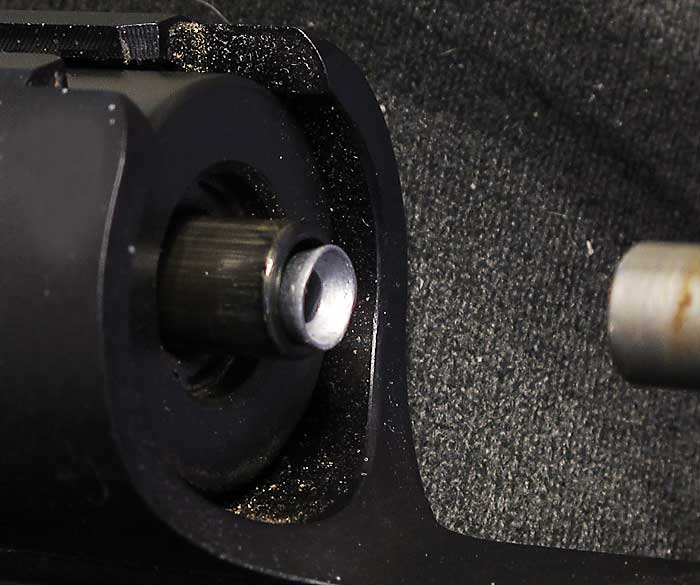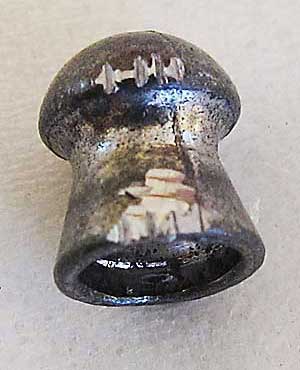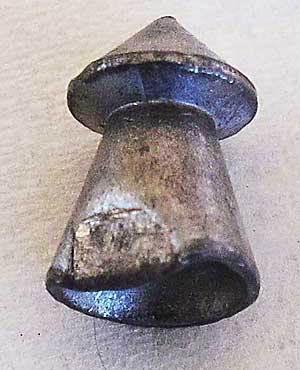by Tom Gaylord
Copyright PyramydAir.com ©2011. All Rights Reserved.
Part 1
This is the second part of my "How to load pellets" series. Yes, there are several tips and things you need to know about loading pellets in pneumatic and CO2 guns. In fact, by improperly loading a pellet -- just that simple act, you can sabotage one of the finest precharged air rifles on the market! I know, because I was there when the whole thing began.
The AirForce Airguns saga
When AirForce Airguns first brought out the Condor rifle in 2004, it was produced in .22 caliber. Little thought was given to .177 because the sheer power of the rifle made it far more efficient in .22. I hand-tested the first 100 rifles they made and verified that each of them would shoot a Crosman Premier .22 caliber pellet faster than 1,250 f.p.s. Since that was how we were advertising the rifle, it was very important to make certain there would be no disappointments.
Over a full year later, we put a .177 barrel on the Condor. That was for the South African market, for whom .22 caliber is considered a firearm. We tested the guns, of course, and that’s when I saw a .177 pellet go 1,486 f.p.s. -- the fastest velocity I have ever witnessed in that caliber. The guns tested fine and would shoot through 1.50 two-by-four boards.
A few months after the rifles began selling in South Africa we started hearing about guns that exhausted all the air in their reservoirs on the first shot. This was the first time we'd heard of such a problem. Well, as chief tester at AirForce, I set about to finding out what was happening, but it took more info from South Africa before I discovered the "problem." I put quotes around the word problem, because it wasn’t a problem at all. It was a self-inflicted problem caused by improper loading. That was something I would never have done if the South Africans hadn’t shown me what they were doing.
They weren’t pushing the pellet all the way flush with the end of the barrel. When the gun fired, the air blast collapsed the pellet and folded it over against the breech face, pinning it there with air pressure. The backpressure held the firing valve open until all the air was exhausted. It was an easy fault to replicate, but only if the pellet wasn't properly seated -- and only in .177 caliber .

By not inserting the pellet until it's flush, the skirt is exposed and can be damaged.
If you load the pellet as shown in the previous image, the air blast will squash the skirt against the side of the barrel and hold the firing valve open, exhausting all the air in the reservoir.
90-degree air transfer ports
Most pneumatics have air transfer ports located at the bottom of their loading ports in the breech. The pellet has to slide over the air hole and into the rifling. In a factory-made gun, the bolt nose is long enough to make this happen most of the time. If you use a thin-skirted pellet with a hollow head, the bolt nose may go into the pellet deeper and not chamber the pellet as far as it needs to be. Then, when the air blast comes through the transfer port, it will bend the bottom skirt of the pellet, causing inaccuracy.
 |
 |
At left is a pellet with chunks of lead removed from the skirt by a burr on the air transfer port. At right is a pellet skirt that's been smashed due to insufficient depth when loading. Either one will ruin any chance of accuracy.
But once people start to modify both CO2 and pneumatic guns, the transfer port problems start to increase with great frequency. Perhaps the most common of these is when the transfer port is enlarged. That often leaves a burr that scours the bottom of the pellet skirt when it's loaded. There's no way you can expect accuracy from a setup like that.
Another problem the modified gun may have is that the bolt nose may be thinned for better air or gas flow. When the nose gets too thin, it may not push pellets to the same depth as a stock bolt nose. You end up with a bent skirt and bad accuracy. You’ll never see this because the pellet has already been shot, but the accuracy will drop way off. Many builders suspect a bad barrel when this happens, and they waste time crowning the muzzle when the real problem is at the breech.
One final problem -- loading gates
I guess what I’m about to say also applies to magazines. Sometimes, those loading gates (where you insert the pellet) can damage the skirt of the pellet if you're not careful to push it in past flush. I had a Chameleon CO2 target pistol that had such a problem. Once I got used to it, it was no trouble at all, but in the beginning I suffered a few damaged skirts and flier pellets.
Buy With Confidence
Get FREE shipping on qualifying orders! Any order $150+ with a shipping address in the contiguous US will receive the option for free ground shipping on items sold & shipped by Pyramyd AIR during checkout. Certain restrictions apply.
Free shipping may not be combined with a coupon unless stated otherwise.
View Shipping Info
We work hard to get all orders placed by 12 pm EST out the door within 24 hours on weekdays
because we know how excited you are to receive your order.
Weekends and holiday shipping times will vary.
During busy holidays, we step our efforts to ship all orders as fast as possible,
but you may experience an additional 1-2 day delay before your order ships.
This may also happen if you change your order during processing.
View Shipping Times
It's important to know that due to state and local laws, there are certain restrictions for various products. It's up to you to research and comply with the laws in your state, county, and city. If you live in a state or city with regulations, you may be able to take advantage of our special FFL program.
U.S. federal law requires that all airsoft products be sold with a 1/4-inch blaze orange muzzle or an orange flash hider to avoid being mistaken for regulated products.
View Shipping Restrictions
Get the most out of your equipment when you work with the expert technicians at Pyramyd AIR. With over 25 years of combined experience, we offer a range of comprehensive in-house services tailored to kickstart your next adventure.
We can test and adjust your equipment in our Pro Shop before shipping, so you receive a product that's ready to perform right out of the box. We can even set up an optic or other equipment so you can get out shooting without the hassle. For bowhunters, our certified master bow technicians provide services such as assembly, optics zeroing, and full equipment setup, which can maximize the potential of your purchase.
By leveraging our expertise and precision, we ensure that your equipment is finely tuned to meet your specific needs and get you ready for your outdoor pursuits. So look out for our services when shopping for something new, and let our experts help you get the most from your outdoor adventures.
View Service Info
Shop and purchase with confidence knowing that all of our products (except airsoft) are protected
by a minimum 1-year manufacturer's warranty from the date of purchase unless otherwise noted on the product page.
A warranty is provided by each manufacturer to ensure that your product is free of defect in both materials and workmanship.
View Warranty Details
Didn't get what you wanted or have a problem? We understand that sometimes things aren't right and our team is serious about resolving these issues quickly. We can often help you fix small to medium issues over the phone or email.
If you need to return an item please read our return policy.
Learn About Returns
Get FREE shipping on qualifying orders! Any order $150+ with a shipping address in the contiguous US will receive the option for free ground shipping on items sold & shipped by Pyramyd AIR during checkout. Certain restrictions apply.
Free shipping may not be combined with a coupon unless stated otherwise.
View Shipping Info
Want More?
Join Our Email List for News and Deals!
Join the Pyramyd AIR mailing list: Our e-mails are filled with new products, deals, sneak peeks, tips and tricks, contests and more - sign up today!
Text JOIN to 91256 and get $10 OFF Your Next $50+ Order!
* By providing your number above, you agree to receive recurring autodialed marketing text msgs (e.g. cart reminders) to the mobile number used at opt-in from Pyramyd AIR on 91256. Reply with birthday MM/DD/YYYY to verify legal age of 21+ in order to receive texts. Consent is not a condition of purchase. Msg frequency may vary. Msg & data rates may apply. Reply HELP for help and STOP to cancel. See Terms and Conditions & Privacy Policy.